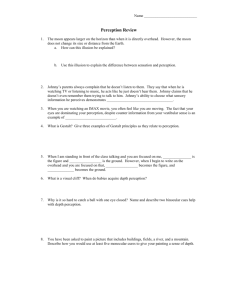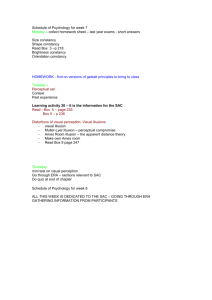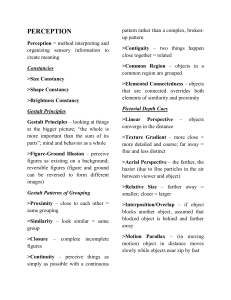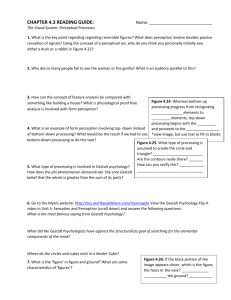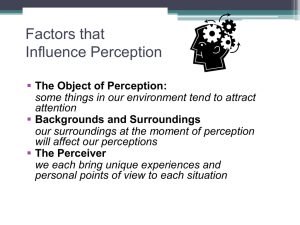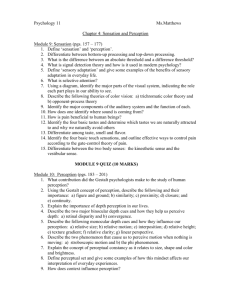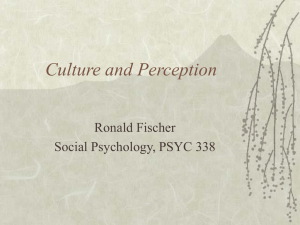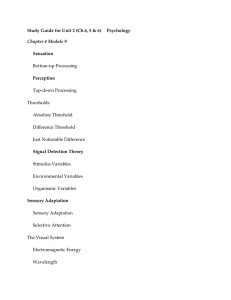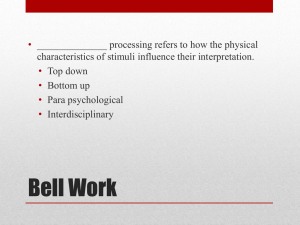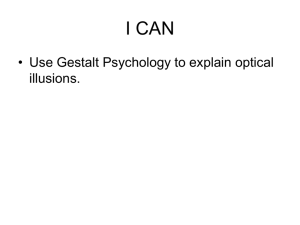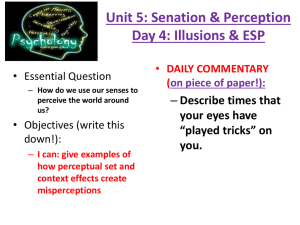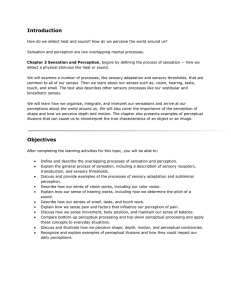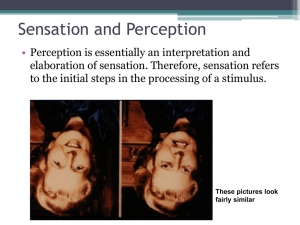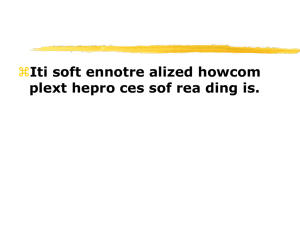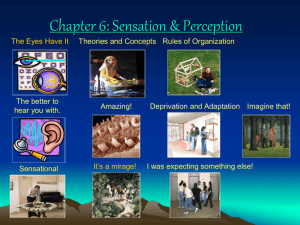Spotlight on Terminology and Language – ESL Pointers
advertisement
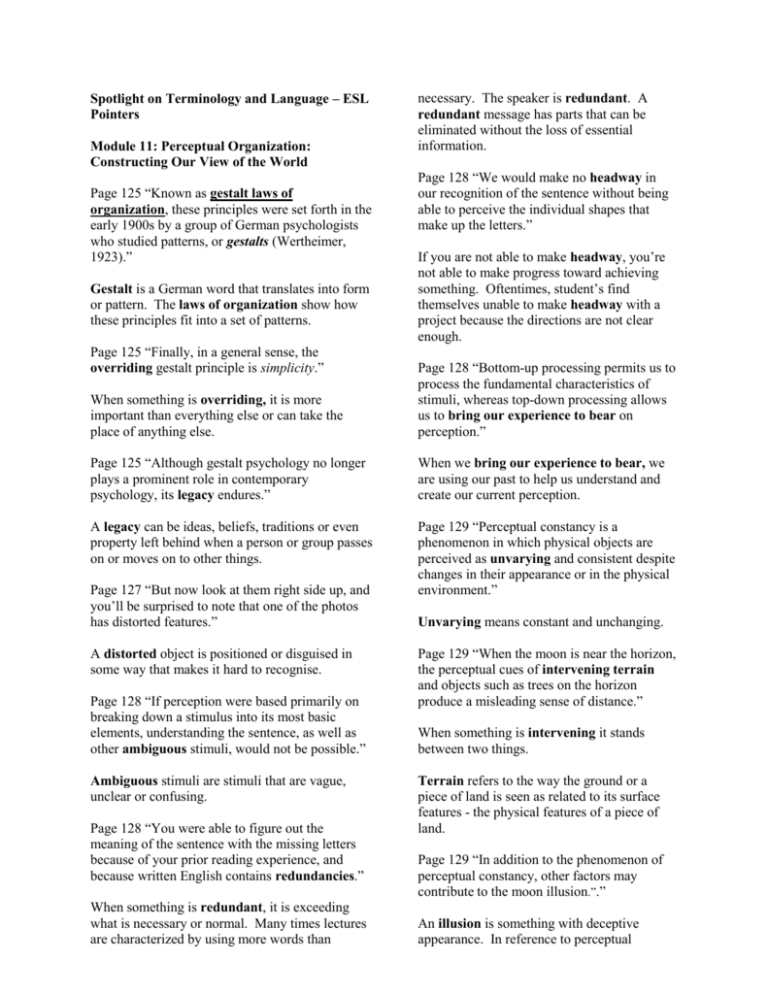
Spotlight on Terminology and Language – ESL Pointers Module 11: Perceptual Organization: Constructing Our View of the World Page 125 “Known as gestalt laws of organization, these principles were set forth in the early 1900s by a group of German psychologists who studied patterns, or gestalts (Wertheimer, 1923).” Gestalt is a German word that translates into form or pattern. The laws of organization show how these principles fit into a set of patterns. Page 125 “Finally, in a general sense, the overriding gestalt principle is simplicity.” necessary. The speaker is redundant. A redundant message has parts that can be eliminated without the loss of essential information. Page 128 “We would make no headway in our recognition of the sentence without being able to perceive the individual shapes that make up the letters.” If you are not able to make headway, you’re not able to make progress toward achieving something. Oftentimes, student’s find themselves unable to make headway with a project because the directions are not clear enough. When something is overriding, it is more important than everything else or can take the place of anything else. Page 128 “Bottom-up processing permits us to process the fundamental characteristics of stimuli, whereas top-down processing allows us to bring our experience to bear on perception.” Page 125 “Although gestalt psychology no longer plays a prominent role in contemporary psychology, its legacy endures.” When we bring our experience to bear, we are using our past to help us understand and create our current perception. A legacy can be ideas, beliefs, traditions or even property left behind when a person or group passes on or moves on to other things. Page 129 “Perceptual constancy is a phenomenon in which physical objects are perceived as unvarying and consistent despite changes in their appearance or in the physical environment.” Page 127 “But now look at them right side up, and you’ll be surprised to note that one of the photos has distorted features.” A distorted object is positioned or disguised in some way that makes it hard to recognise. Page 128 “If perception were based primarily on breaking down a stimulus into its most basic elements, understanding the sentence, as well as other ambiguous stimuli, would not be possible.” Ambiguous stimuli are stimuli that are vague, unclear or confusing. Page 128 “You were able to figure out the meaning of the sentence with the missing letters because of your prior reading experience, and because written English contains redundancies.” When something is redundant, it is exceeding what is necessary or normal. Many times lectures are characterized by using more words than Unvarying means constant and unchanging. Page 129 “When the moon is near the horizon, the perceptual cues of intervening terrain and objects such as trees on the horizon produce a misleading sense of distance.” When something is intervening it stands between two things. Terrain refers to the way the ground or a piece of land is seen as related to its surface features - the physical features of a piece of land. Page 129 “In addition to the phenomenon of perceptual constancy, other factors may contribute to the moon illusion.”.” An illusion is something with deceptive appearance. In reference to perceptual constancy, an illusion is a misinterpretation of an experience of sensory perception. Page 129 “The brain integrates the two images into one composite view, but it also recognizes the difference in images and uses it to estimate the distance of an object from us.” A composite view means a combined view. Page 129 “The difference in the images seen by the left eye and the right eye is known as binocular disparity.” A disparity is a discrepancy or difference. Page 130 “The fact that the discrepancy between the images in the two eyes varies according to the distance of objects that we view provides us with a means of determining distance.” A discrepancy is a difference between two instances of the same thing. Page 130 “The monocular cue of texture gradient provides information about distance because the details of things that are far away are less distinct (Proffitt, 2006).” When something is distinct it is clear and well defined. Page 133 “Although all kinds of explanations for visual illusions have been suggested, most concentrate either on the physical operation of the eye or on our misinterpretation of the visual stimulus.”” When someone makes a misinterpretation, he or she does not understand something correctly. Page 133 “In contrast, a different explanation for the illusion suggests that we unconsciously attribute particular significance to each of the lines (Gregory, 1978; Redding & Hawley, 1993).” When we do something unconsciously we do it automatically, or without thinking about it. Page 133 “Despite the complexity of the latter explanation, a good deal of evidence supports it.” Complexity means having many parts. Page 134 “As the example of the Zulu indicates, the culture in which we are raised has clear consequences for how we perceive the world.” Consequences are the results of an action. Page 131 “If you look carefully at the Parthenon, one of the most famous buildings of ancient Greece, still standing at the top of an Athens hill, you’ll see that it was built with a bulge on one side.” A bulge is a rounded part of something that sticks out, or is not in line with the rest of the object. Page 131 “If it didn’t have that bulge – and quite a few other a ‘tricks’ like it, such as columns that incline inward – it would look as if it were crooked and about to fall down.” In this case the “tricks” are methods of arranging the parts of a building so that it appears a certain way – hiding parts that make the building look funny, and drawing the eye to the parts that are beautiful. Crooked means not straight, or not in a straight line. Page 134 “Sometimes called the ‘devil’s tuning fork’, it is likely to produce a mindboggling effect, as the center tine of the fork alternates between appearing and disappearing.” A mind-boggling effect is one that confuses the mind, causing it to switch back and forth between choices. Page 134 “The misinterpretations created by visual illusions are ultimately due, then, to errors in both fundamental visual processing and the way the brain interprets the information it receives.” When we misinterpret something we make a mistake in understanding it. Page 134 “But visual illusions, by illustrating something fundamental about perceptions, become more than mere psychological curiosities.” Curiosities are strange or unusual things that usually do not cause changes in the way people behave or see something, like a cow with six legs – it may be interesting, but it wouldn’t stop everyone from buying meat at a grocery store. Page 136 “Subliminal perception refers to the perception of messages about which we have no awareness.” Subliminal messages are brief auditory or visual messages that are presented below the absolute threshold, so that their chance of perception is less than fifty percent. Page 133 “ In short, although we are able to perceive at least some kinds of information of which we are unaware, there’s little evidence that subliminal messages can change our attitudes or behavior in any substantial way (Abrams, Klinger, & Greenwald,2002; Pratkanis, Epley, & Savitsky, 2007; Randolph-Seng & Nielsen, 2009).).” Substantial means large or many. Page 135 “Although half of North America believes it exists, most psychologists reject the existence of ESP, asserting that there is no sound documentation of the phenomenon (Swets & Bjork, 1990; Hyman, 1994; Gallup Poll, 2001).” Having sound documentation means that there is written proof of scientific experiments or other agreed upon accounts that logically demonstrates the correctness of the premise under study. Page 135 “According to proponents of ESP, reliable evidence exists for an ‘anomalous process of information transfer’, or psi.” Things that are anomalous are strange or out of the ordinary. Page 135 “These researchers, who painstakingly reviewed considerable evidence, argue that a cumulative body of research shows reliable support for the existence of psi (Bem & Honorton, 1994; Storm & Ertel, 2001; Parra & Argibay, 2007).” Painstakingly means slow, careful steps in performing some action, making sure that everything possible is examined before going on to the next step, and making sure that all the steps necessary to accomplish the task are done.

